Non-Random Distribution of G-Quadruplex Structures Reveals Regulatory and Ecological Adaptations in Bacterial Genomes
Abstract
1. Introduction
2. Results
2.1. Overall Characteristics of the Bacterial Dataset
2.2. Enrichment of G4s in Specific Genomic Regions of Bacteria
2.3. Host Environment as a Key Determinant of Bacterial G4 Distribution
3. Discussion
4. Materials and Methods
4.1. Bacterial Reference Genomes and Annotations
4.2. Determination of Bacterial Habitats and Classification
4.3. Prediction and Classification of Bacterial Genomic G4s
4.4. Generation of Random Genomes
4.5. Quantitative Evaluation of the Position Between G4s and Coding Regions
Supplementary Materials
Author Contributions
Funding
Institutional Review Board Statement
Informed Consent Statement
Data Availability Statement
Conflicts of Interest
References
- Gellert, M.; Lipsett, M.N.; Davies, D.R. Helix Formation by Guanylic Acid. Proc. Natl. Acad. Sci. USA 1962, 48, 2013–2018. [Google Scholar] [CrossRef]
- Dvorkin, S.A.; Karsisiotis, A.I.; Da Silva, M.W. Encoding canonical DNA quadruplex structure. Sci. Adv. 2018, 4, eaat3007. [Google Scholar] [CrossRef]
- Popenda, M.; Miskiewicz, J.; Sarzynska, J.; Zok, T.; Szachniuk, M. Topology-based classification of tetrads and quadruplex structures. Bioinformatics 2020, 36, 1129–1134. [Google Scholar] [CrossRef]
- Huppert, J.L.; Balasubramanian, S. G-quadruplexes in promoters throughout the human genome. Nucleic Acids Res. 2007, 35, 406–413, Erratum in Nucleic Acids Res. 2007, 35, 2105. [Google Scholar] [CrossRef] [PubMed]
- Chambers, V.S.; Marsico, G.; Boutell, J.M.; Di Antonio, M.; Smith, G.P.; Balasubramanian, S. High-throughput sequencing of DNA G-quadruplex structures in the human genome. Nat. Biotechnol. 2015, 33, 877–881. [Google Scholar] [CrossRef] [PubMed]
- Lombardi, E.P.; Londoño-Vallejo, A. A guide to computational methods for G-quadruplex prediction. Nucleic Acids Res. 2020, 48, 1603. [Google Scholar] [CrossRef] [PubMed]
- Chashchina, G.V.; Tevonyan, L.L.; Beniaminov, A.D.; Kaluzhny, D.N. Taq-Polymerase Stop Assay to Determine Target Selectivity of G4 Ligands in Native Promoter Sequences of MYC, TERT, and KIT Oncogenes. Pharmaceuticals 2023, 16, 544. [Google Scholar] [CrossRef]
- Varshney, D.; Spiegel, J.; Zyner, K.; Tannahill, D.; Balasubramanian, S. The regulation and functions of DNA and RNA G-quadruplexes. Nat. Rev. Mol. Cell Biol. 2020, 21, 459–474. [Google Scholar] [CrossRef]
- Kosiol, N.; Juranek, S.; Brossart, P.; Heine, A.; Paeschke, K. G-quadruplexes: A promising target for cancer therapy. Mol. Cancer 2021, 20, 40. [Google Scholar] [CrossRef]
- Ruggiero, E.; Zanin, I.; Terreri, M.; Richter, S.N. G-Quadruplex Targeting in the Fight against Viruses: An Update. Int. J. Mol. Sci. 2021, 22, 10984. [Google Scholar] [CrossRef]
- Wang, E.; Thombre, R.; Shah, Y.; Latanich, R.; Wang, J. G-Quadruplexes as pathogenic drivers in neurodegenerative disorders. Nucleic Acids Res. 2021, 49, 4816–4830. [Google Scholar] [CrossRef]
- Bartas, M.; Čutová, M.; Brázda, V.; Kaura, P.; Šťastný, J.; Kolomazník, J.; Coufal, J.; Goswami, P.; Červeň, J.; Pečinka, P. The Presence and Localization of G-Quadruplex Forming Sequences in the Domain of Bacteria. Molecules 2019, 24, 1711–1724. [Google Scholar] [CrossRef]
- Evans, L.; Kotar, A.; Valentini, M.; Filloux, A.; Jamshidi, S.; Plavec, J.; Rahman, K.M.; Vilar, R. Identification and characterisation of G-quadruplex DNA-forming sequences in the Pseudomonas aeruginosa genome. RSC Chem. Biol. 2023, 4, 94–100. [Google Scholar] [CrossRef]
- Cueny, R.R.; Mcmillan, S.D.; Keck, J.L. G-quadruplexes in bacteria: Insights into the regulatory roles and interacting proteins of non-canonical nucleic acid structures. Crit. Rev. Biochem. Mol. Biol. 2022, 57, 539–561. [Google Scholar] [CrossRef] [PubMed]
- Yadav, P.; Kim, N.; Kumari, M.; Verma, S.; Sharma, T.K.; Yadav, V.; Kumar, A. G-Quadruplex Structures in Bacteria: Biological Relevance and Potential as an Antimicrobial Target. J. Bacteriol. 2021, 203, e0057720. [Google Scholar] [CrossRef]
- Harris, L.M.; Merrick, C.J. G-Quadruplexes in Pathogens: A Common Route to Virulence Control? PLoS Pathog. 2015, 11, e1004562. [Google Scholar] [CrossRef] [PubMed]
- Cahoon, L.A.; Seifert, H.S. An Alternative DNA Structure Is Necessary for Pilin Antigenic Variation in Neisseria gonorrhoeae. Science 2009, 325, 764–767. [Google Scholar] [CrossRef]
- Thakur, R.S.; Desingu, A.; Basavaraju, S.; Subramanya, S.; Rao, D.N.; Nagaraju, G. Mycobacterium tuberculosis DinG Is a Structure-specific Helicase That Unwinds G4 DNA. J. Biol. Chem. 2014, 289, 25112–25136. [Google Scholar] [CrossRef] [PubMed]
- Rawal, P.; Kummarasetti, V.B.R.; Ravindran, J.; Kumar, N.; Halder, K.; Sharma, R.; Mukerji, M.; Das, S.K.; Chowdhury, S. Genome-wide prediction of G4 DNA as regulatory motifs: Role in Escherichia coli global regulation. Genome Res. 2006, 16, 644–655. [Google Scholar] [CrossRef]
- Lyu, B.; Song, Q.S. The intricate relationship of G-Quadruplexes and bacterial pathogenicity islands. Elife 2024, 12, RP91985. [Google Scholar] [CrossRef]
- Ciaco, S.; Aronne, R.; Fiabane, M.; Mori, M. The Rise of Bacterial G-Quadruplexes in Current Antimicrobial Discovery. ACS Omega 2024, 9, 24163–24180. [Google Scholar] [CrossRef]
- Okuda, S.; Kawashima, S.; Kobayashi, K.; Ogasawara, N.; Kanehisa, M.; Goto, S. Characterization of relationships between transcriptional units and operon structures in Bacillus subtilis and Escherichia coli. BMC Genom. 2007, 8, 48. [Google Scholar] [CrossRef]
- Amemiya, H.M.; Schroeder, J.; Freddolino, P.L. Nucleoid-associated proteins shape chromatin structure and transcriptional regulation across the bacterial kingdom. Transcription 2021, 12, 182–218. [Google Scholar] [CrossRef]
- Power, J.J.; Pinheiro, F.; Pompei, S.; Kovacova, V.; Yüksel, M.; Rathmann, I.; Förster, M.; Lässig, M.; Maier, B. Adaptive evolution of hybrid bacteria by horizontal gene transfer. Proc. Natl. Acad. Sci. USA 2021, 118, e2007873118. [Google Scholar] [CrossRef]
- Torrance, E.L.; Burton, C.; Diop, A.; Bobay, L.-M. Evolution of homologous recombination rates across bacteria. Proc. Natl. Acad. Sci. USA 2024, 121, e2316302121. [Google Scholar] [CrossRef] [PubMed]
- Singer Ga, C.; Hickey, D.A. Thermophilic prokaryotes have characteristic patterns of codon usage, amino acid composition and nucleotide content. Gene 2003, 317, 39–47. [Google Scholar] [CrossRef]
- Hu, E.Z.; Lan, X.R.; Liu, Z.L.; Gao, J.; Niu, D.-K. A positive correlation between GC content and growth temperature in prokaryotes. BMC Genom. 2022, 23, 110. [Google Scholar] [CrossRef]
- Lobry, J.R.; Chessel, D. Internal correspondence analysis of codon and amino-acid usage in thermophilic bacteria. J. Appl. Genet. 2003, 44, 235–261. [Google Scholar]
- Dewar, A.E.; Hao, C.; Belcher, L.J.; Ghoul, M.; West, S.A. Bacterial lifestyle shapes pangenomes. Proc. Natl. Acad. Sci. USA 2024, 121, e2320170121. [Google Scholar] [CrossRef] [PubMed]
- Zhang, M.L.; Han, L.X.; Liao, C.Z.; Su, W.; Jiang, C. Comparative genomics reveals key adaptive mechanisms in pathogen host-niche specialization. Front. Microbiol. 2025, 16, 1543610. [Google Scholar] [CrossRef] [PubMed]
- Lyu, B.; Niu, K.; Anderson, D.; Feng, Q.; Song, Q. G-quadruplex structures in 16S rRNA regions correlate with thermal adaptation in prokaryotes. Nucleic Acids Res. 2025, 53, gkaf042. [Google Scholar] [CrossRef] [PubMed]
- Biver, T. Discriminating between Parallel, Anti-Parallel and Hybrid G-Quadruplexes: Mechanistic Details on Their Binding to Small Molecules. Molecules 2022, 27, 4165. [Google Scholar] [CrossRef] [PubMed]
- Frasson, I.; Pirota, V.; Richter, S.N.; Doria, F. Multimeric G-quadruplexes: A review on their biological roles and targeting. Int. J. Biol. Macromol. 2022, 204, 89–102. [Google Scholar] [CrossRef] [PubMed]
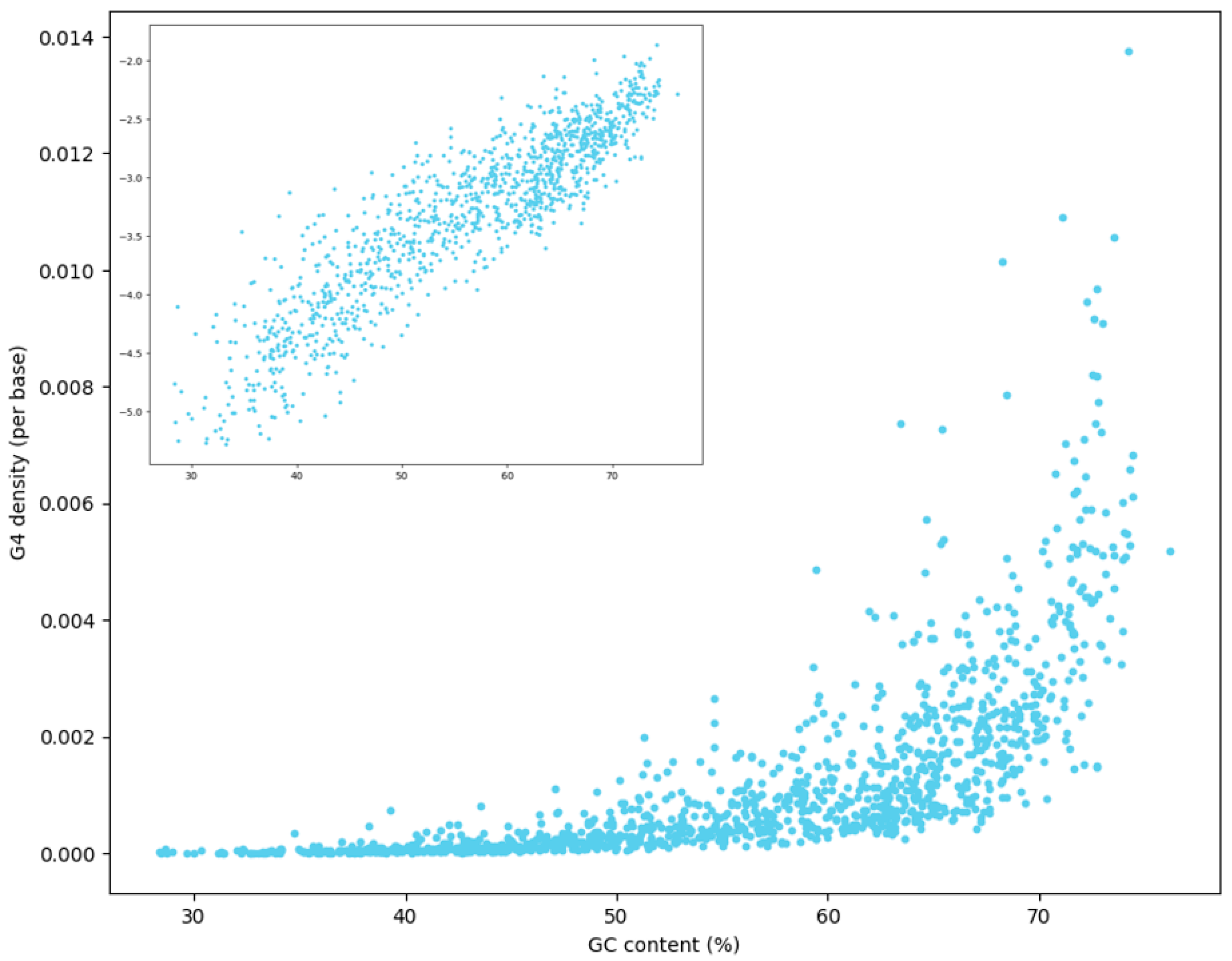
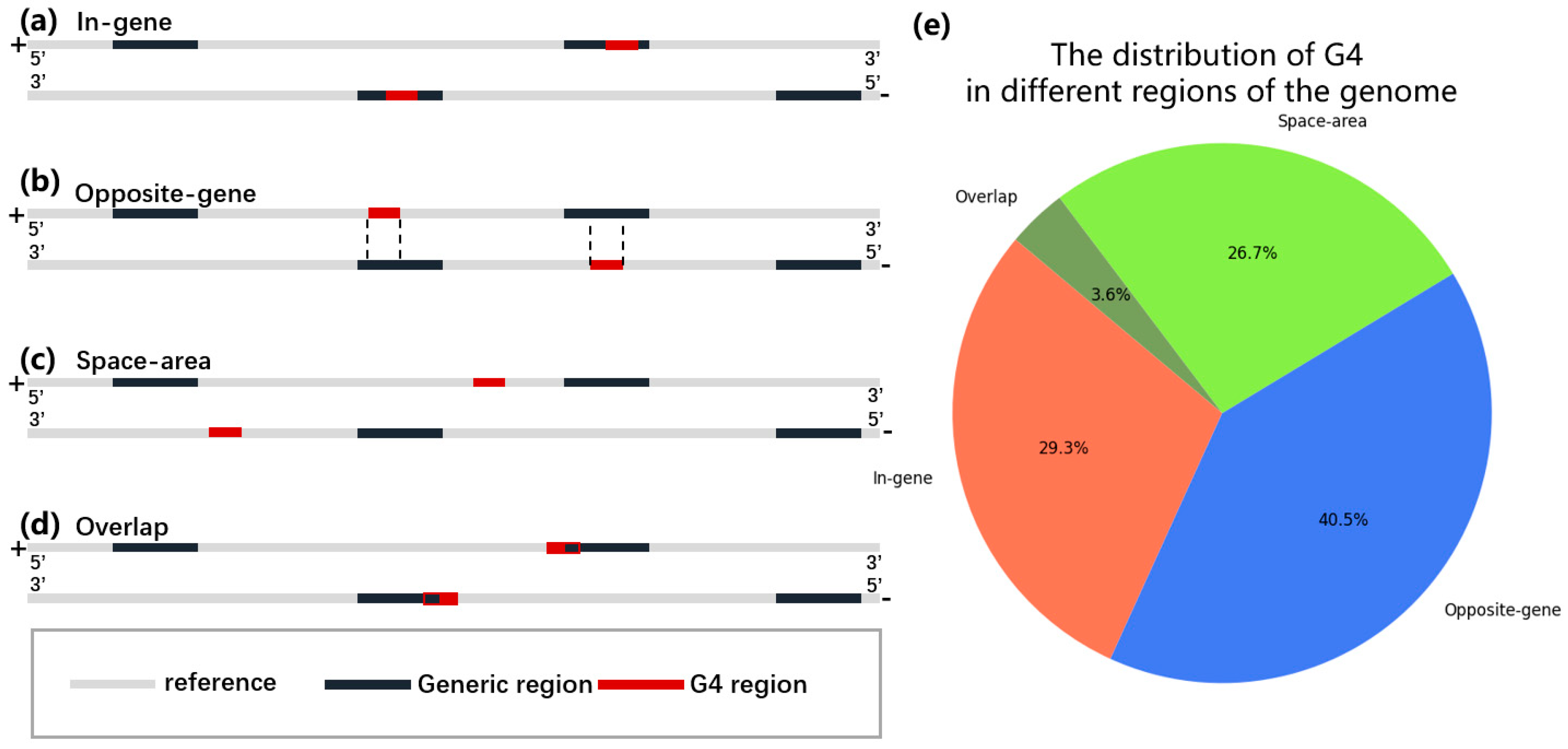
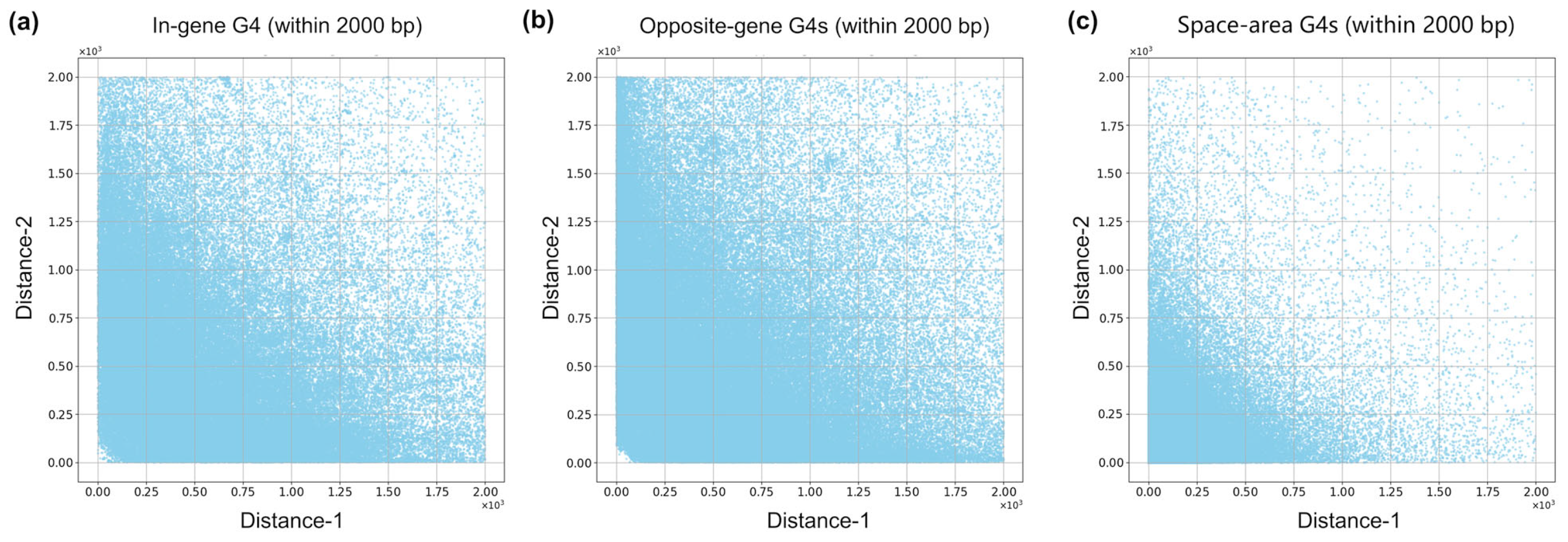
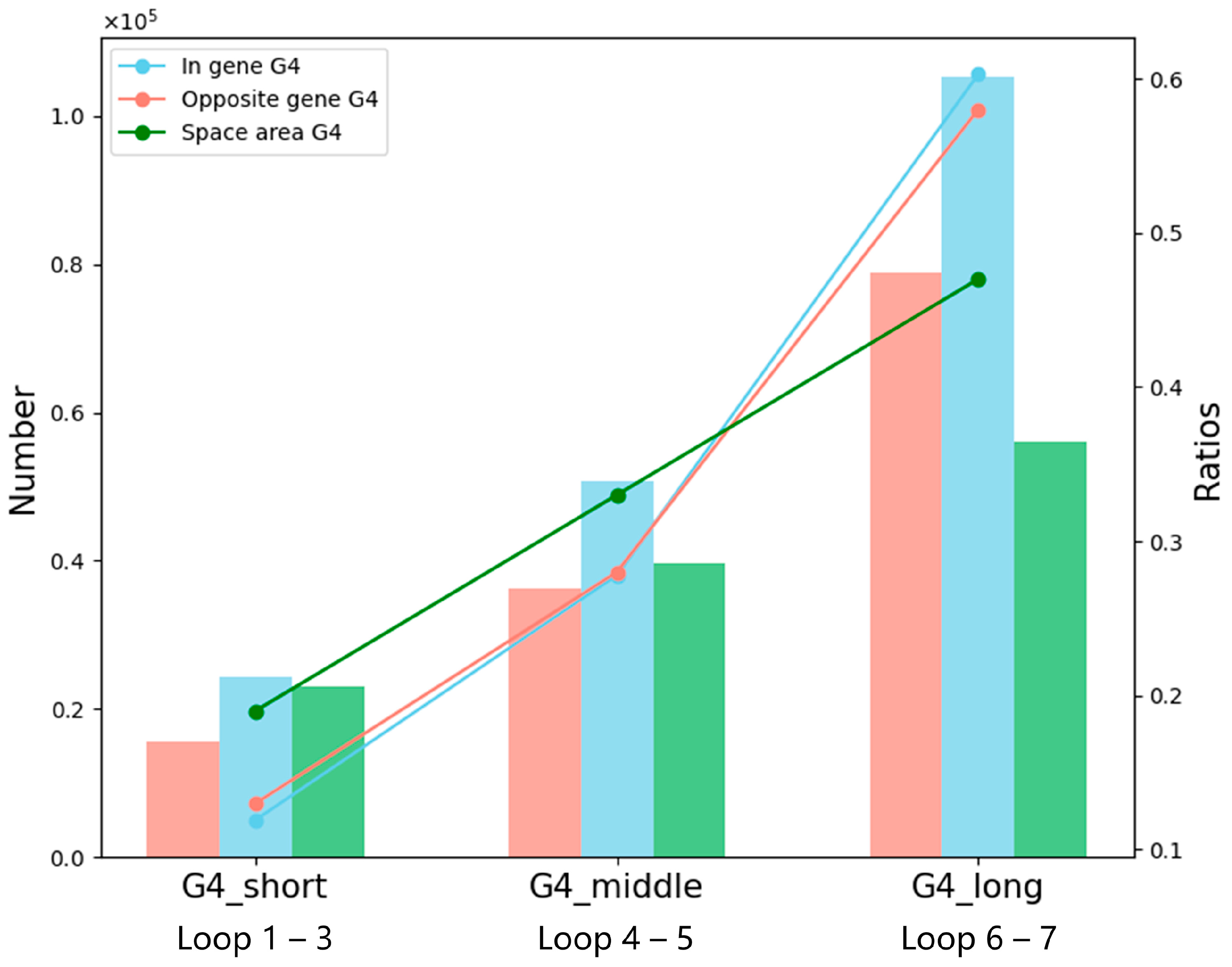

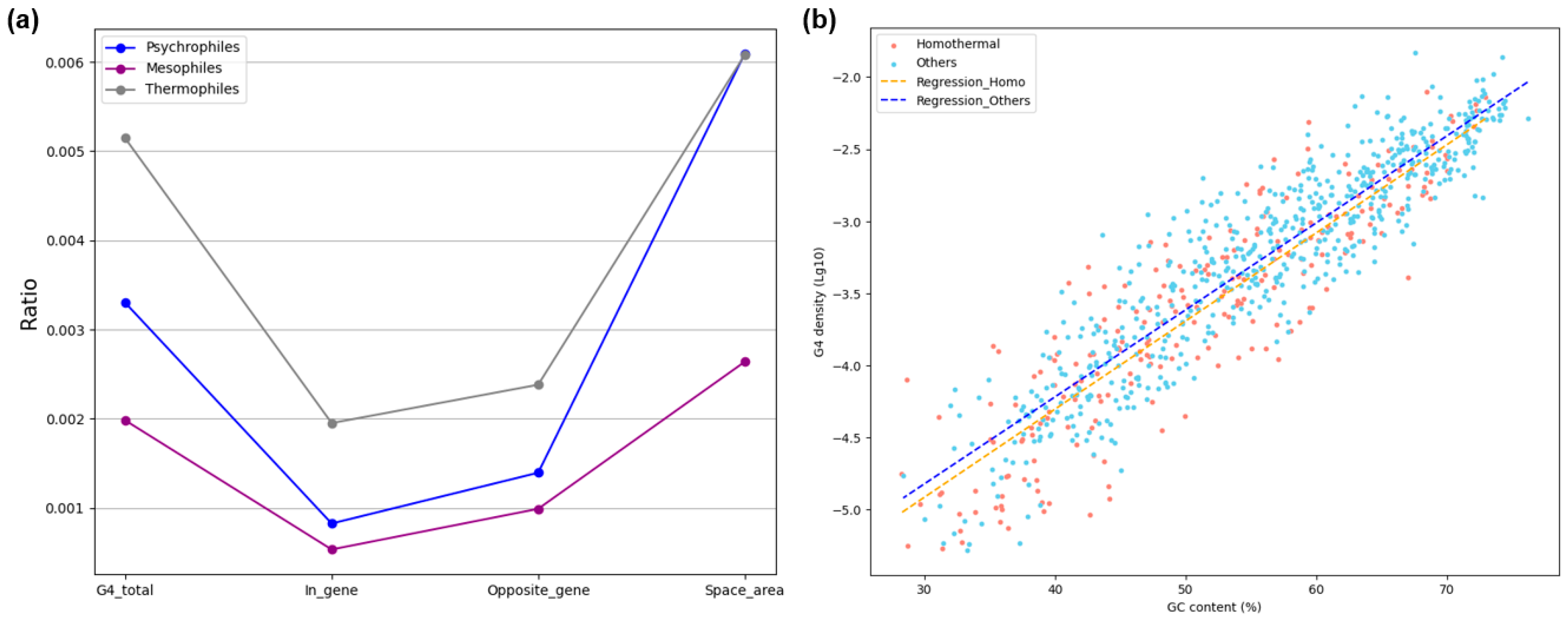
Disclaimer/Publisher’s Note: The statements, opinions and data contained in all publications are solely those of the individual author(s) and contributor(s) and not of MDPI and/or the editor(s). MDPI and/or the editor(s) disclaim responsibility for any injury to people or property resulting from any ideas, methods, instructions or products referred to in the content. |
© 2025 by the authors. Licensee MDPI, Basel, Switzerland. This article is an open access article distributed under the terms and conditions of the Creative Commons Attribution (CC BY) license (https://creativecommons.org/licenses/by/4.0/).
Share and Cite
Fu, J.; Xiao, K.; He, Y.; Tu, J. Non-Random Distribution of G-Quadruplex Structures Reveals Regulatory and Ecological Adaptations in Bacterial Genomes. Int. J. Mol. Sci. 2025, 26, 10025. https://doi.org/10.3390/ijms262010025
Fu J, Xiao K, He Y, Tu J. Non-Random Distribution of G-Quadruplex Structures Reveals Regulatory and Ecological Adaptations in Bacterial Genomes. International Journal of Molecular Sciences. 2025; 26(20):10025. https://doi.org/10.3390/ijms262010025
Chicago/Turabian StyleFu, Jiye, Ke Xiao, Yukun He, and Jing Tu. 2025. "Non-Random Distribution of G-Quadruplex Structures Reveals Regulatory and Ecological Adaptations in Bacterial Genomes" International Journal of Molecular Sciences 26, no. 20: 10025. https://doi.org/10.3390/ijms262010025
APA StyleFu, J., Xiao, K., He, Y., & Tu, J. (2025). Non-Random Distribution of G-Quadruplex Structures Reveals Regulatory and Ecological Adaptations in Bacterial Genomes. International Journal of Molecular Sciences, 26(20), 10025. https://doi.org/10.3390/ijms262010025





